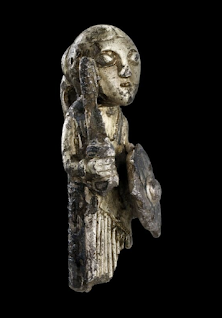Sessions also said in 2014 that marijuana can't be safer than alcohol because, "Lady Gaga says she's addicted to it."
He was referring to a statement made in 2013 by Gaga to a radio show, about smoking a lot of marijuana after she'd broken her hip onstage and was dealing with pain, anxiety and "coping." With weeks, Gaga had backpedaled on her statement, telling a talk show host she still loves to smoke pot, because it makes her feel like she's 17 again.
 In 2012, Gaga lit up a joint onstage at her concert in Amsterdam, declaring weed "wondrous." She was quoted as telling The Sun newspaper: "I want you to know it has totally changed my life and I’ve really cut down on drinking." That year, both she and Rihanna dressed up as a pot fairy for Halloween (pictured).
In 2012, Gaga lit up a joint onstage at her concert in Amsterdam, declaring weed "wondrous." She was quoted as telling The Sun newspaper: "I want you to know it has totally changed my life and I’ve really cut down on drinking." That year, both she and Rihanna dressed up as a pot fairy for Halloween (pictured).In a 2011 60 Minutes interview, Gaga told Anderson Cooper: "I smoke a lot of pot when I write music. I'm not gonna sugarcoat it for '60 Minutes.' I drink a lot of whiskey and I smoke weed when I write." She added, "I don't do it a lot because it's not good for my voice." Sounds like she was able to practice moderation, unless she was suffering from the pain of a broken hip.
At a Congressional hearing in April, Sessions fretted that legalizing marijuana sends a dangerous message, and longed for the days of Nancy Reagan's "Just Say No" campaign. He said, "I can't tell you how concerning it is for me, emotionally and personally, to see the possibility that we will reverse the progress that we've made.... It was the prevention movement that really was so positive, and it led to this decline. The creating of knowledge that this drug is dangerous, it cannot be played with, it is not funny, it's not something to laugh about, and trying to send that message with clarity, that good people don't smoke marijuana." (Ah, but great ones do.)
Reformers are quite worried about whether Sessions will make good on candidate Trump's promises to leave state marijuana laws alone. Coming in after 8 of 9 states passed ballot measure for marijuana law reform, and 80% of US voters favor medical marijuana, Sessions will be going against the will of the electorate if he chooses to start cracking down on state-legal enterprises.
As I write this, a standing-room-only session at the American Society of Regional Anesthesia and Pain Medicine is discussing, "Cannabinoids for Pain: Science, Politics and Clinical Applications," including the requisite anti-pot propaganda and a researcher studying the molecular mechanisms of cannabinoid receptor activation in skin cells for induction of analgesia, and the role of endocannabinoids in postoperative pain. Every week, new studies are coming out about the efficacy and safety of cannabis for pain relief.
A 2014 study published in the Journal of the American Medical Society (JAMA) found that medical marijuana states have 25% fewer opioid overdose rates than do states without reform. Subsequent studies have found reductions in opioid use, abuse, and traffic fatalities related to opioids in medical marijuana states. Yet the new administration could roll back these reforms and leave pain patients, heroin addicts, and alcoholics without the safer alternative of cannabis.
Yet, Cal NORML continues to get complaints from patients at Kaiser Healthcare who are being kicked off their opioid pain medications because they are augmenting their therapy with marijuana. Kaiser Health News (a supposedly unaffiliated PR arm), has not reported on any of the positive studies about marijuana and opiates and instead just interviewed an anti-tobacco zealot opining that marijuana legalization will lead to more cigarette smoking.















